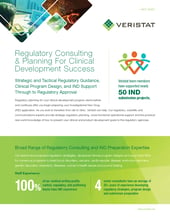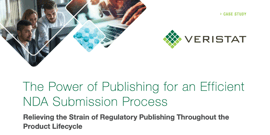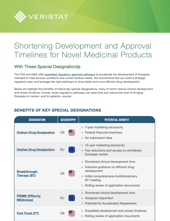Emergency Use Authorizations
ART PODCAST | SEASON 3 | EPISODE 2
In this episode of Advancing Revolutionary Therapies, Kevin Hennegan, Director of Regulatory Affairs at Veristat, provides an overview of the Emergency Use Authorization program available through the U.S. FDA.
Check out the full episode to learn more about navigating the U.S. regulatory environment and the many nuances key to the success of an Emergency Use Authorization application – or read the summary below.
FDA’s Emergency Use Authorization Program
What are Emergency Use Authorizations (EUAs)?
Kevin: Emergency Use Authorizations are a mechanism that allows the US FDA to facilitate the availability of medical countermeasures for chemical, biological, radiological, and nuclear (CBRN) agents, including emerging infectious disease threats, such as COVID-19 and pandemic influenza, during times of national emergency. Products that receive EUA may be legally marketed and sold in the United States for the duration of the emergency or until authorization is revoked by FDA.
When can Emergency Use Authorizations be issued?
Kevin: FDA may only issue EUAs when there has been a determination of an emergency involving CBRN agents by the US Secretary of Homeland Security, the Secretary of Defense, or the Secretary of Health and Human Services. The circumstances that exist must also justify the emergency use of drugs, biologics, and/or medical devices. For FDA to issue an emergency use authorization, there are four primary criteria that be met:
- The threat agent must be capable of causing a serious or life-threatening illness.
- There must be enough evidence of effectiveness to conclude that the product may be effective for its proposed use (a lower threshold than the effectiveness standard required for full approval.
- A risk-benefit analysis must conclude that the known and potential benefits of the product outweigh the known and potential risks, including consideration of the risks posed by the threat agent.
- There must be no “adequate, approved, and available alternative” to the candidate product. The standards for “adequate” and “available” are usually interpreted quite broadly. For example, a product may be considered “unavailable” if there aren’t enough existing doses to meet the emergency need. A product may be “inadequate” if it has contraindications for particular sub-groups that are at risk in the emergency.
Applying for an Emergency Use Authorization
What is the application process?
Kevin: Prior to submitting an Emergency Use Authorization application, FDA encourages sponsors to engage the Agency in pre-EUA interactions to discuss the potential suitability of the product for EUA consideration. Although this is not an absolute requirement, these meetings are extremely beneficial and important. Emergency situations evolve rapidly, so discussions with the Agency help to keep you on the right track with respect to data requirements, trial designs, and even application format, ensuring a faster FDA review and increasing the probability of success when a full EUA is submitted.
Tip!
Pre-EUA meetings follow the same request process and timelines as other FDA meetings, such as pre-IND or pre-NDA meetings, and are considered Type B meetings with respect to the PDUFA classifications, though they are usually treated separately from other submissions on file with FDA.
When a sponsor believes they have collected all the data necessary to fulfill the requirements, they can proceed with submitting their request for EUA. For drug and biologic submissions, submitting the application electronically in Common Technical Document format may help accelerate the FDA’s review of the application. However, acknowledging the emergency conditions, FDA does also accept other formats, including paper submissions.
What are the data requirements for Emergency Use Authorizations?
Kevin: The data required to support an EUA must be sufficient to fulfill the four primary criteria mentioned previously. In practice, this often means a lower data threshold than is typically required for a full NDA or BLA. This might include regulatory flexibility with respect to completion of full process validation, or a significantly shorter duration of safety follow up at the time of the EUA application. However, the data threshold can and does vary from one public health emergency to another and even through the life cycle of a given public health emergency, based on understandings of real and perceived risks.
COVID-19 Pandemic Example: The drug hydroxychloroquine received an EUA early in the pandemic based on small, preliminary clinical studies. Subsequent studies did not validate those early results, and FDA revoked the EUA.
While the detailed data requirements vary, FDA does recommend that the following elements be included in any EUA application:
- A description of the product and its approval status regardless of if the product is unapproved or approved but for a different use than the EUA.
- Available safety and effectiveness data
- A discussion of the risks and benefits including a discussion of the risks of the threat agent that spurred the emergency.
- Chemistry, manufacturing, and control information
- The quantity of available product. the production capabilities of the manufacturing site, and the proposed labeling information and fact sheets.
According to FDA guidance, Sponsors with right of reference may refer to data previously submitted to FDA in a marketing application, IND, or master file. However, in Veristat’s recent experience, FDA has objected to cross-referencing INDs and prefers the data to be submitted directly in the EUA application. This is particularly important if the cross-referenced data is not in eCTD format, as evaluating non-CTD data will significantly slow down FDA’s review.
Setting Up for Success: Transitioning from EUA to a Full Approval
How long does an Emergency Use Authorization last?
Kevin: In general, EUAs remain in effect for the duration of the emergency that precipitated their issuance. When the emergency declaration is lifted, EUAs are no longer in effect, and the product can no longer be marketed or commercially distributed within the United States. FDA will continually monitor the state of emergency as it evolves and may revoke EUAs if the risk-benefit profile changes or if conditions of the EUA are not met.
If you successfully obtain an EUA, how can you convert them to full approvals?
Kevin: Emergency Use Authorizations cannot be directly converted into full approvals. Sponsors must submit a full marketing application appropriate to the product type. A formal issuance of an EUA does not alter the data requirements necessary to support full product approval, but in a practical sense, an EUA does not necessarily have no influence on the full marketing application. Those impacts may be positive (such as a larger sample size for the safety database) or negative (such as a more challenging environment for conducting controlled clinical trials), so it is important to plan ahead and discuss the post-EUA clinical development plan with FDA during the pre-EUA meetings and interactions.

















